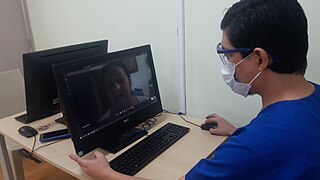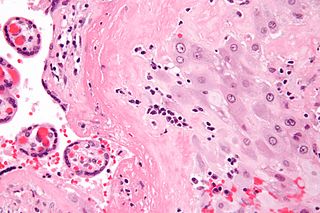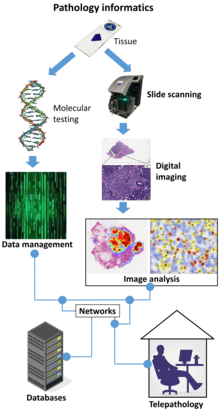
Pathology is the study of disease and injury. The word pathology also refers to the study of disease in general, incorporating a wide range of biology research fields and medical practices. However, when used in the context of modern medical treatment, the term is often used in a narrower fashion to refer to processes and tests that fall within the contemporary medical field of "general pathology", an area that includes a number of distinct but inter-related medical specialties that diagnose disease, mostly through analysis of tissue and human cell samples. Idiomatically, "a pathology" may also refer to the predicted or actual progression of particular diseases, and the affix pathy is sometimes used to indicate a state of disease in cases of both physical ailment and psychological conditions. A physician practicing pathology is called a pathologist.

Histopathology refers to the microscopic examination of tissue in order to study the manifestations of disease. Specifically, in clinical medicine, histopathology refers to the examination of a biopsy or surgical specimen by a pathologist, after the specimen has been processed and histological sections have been placed onto glass slides. In contrast, cytopathology examines free cells or tissue micro-fragments.

Telehealth is the distribution of health-related services and information via electronic information and telecommunication technologies. It allows long-distance patient and clinician contact, care, advice, reminders, education, intervention, monitoring, and remote admissions. Telemedicine is sometimes used as a synonym, or is used in a more limited sense to describe remote clinical services, such as diagnosis and monitoring. When rural settings, lack of transport, a lack of mobility, conditions due to outbreaks, epidemics or pandemics, decreased funding, or a lack of staff restrict access to care, telehealth may bridge the gap as well as provide distance-learning; meetings, supervision, and presentations between practitioners; online information and health data management and healthcare system integration. Telehealth could include two clinicians discussing a case over video conference; a robotic surgery occurring through remote access; physical therapy done via digital monitoring instruments, live feed and application combinations; tests being forwarded between facilities for interpretation by a higher specialist; home monitoring through continuous sending of patient health data; client to practitioner online conference; or even videophone interpretation during a consult.

Auramine O is a diarylmethane dye used as a fluorescent stain. In its pure form, Auramine O appears as yellow needle crystals. It is insoluble in water and soluble in ethanol and DMSO.

Paired-like homeobox 2b (PHOX2B), also known as neuroblastoma Phox (NBPhox), is a protein that in humans is encoded by the PHOX2B gene located on chromosome 4.

Virtual microscopy is a method of posting microscope images on, and transmitting them over, computer networks. This allows independent viewing of images by large numbers of people in diverse locations. It involves a synthesis of microscopy technologies and digital technologies. The use of virtual microscopes can transform traditional teaching methods by removing the reliance on physical space, equipment, and specimens to a model that is solely dependent upon computer-internet access. This increases the convenience of accessing the slide sets and making the slides available to a broader audience. Digitized slides can have a high resolution and are resistant to being damaged or broken over time.
Soft tissue pathology is the subspecialty of surgical pathology which deals with the diagnosis and characterization of neoplastic and non-neoplastic diseases of the soft tissues, such as muscle, adipose tissue, tendons, fascia, and connective tissues. Many malignancies of the soft tissues are challenging for the pathologist to diagnose through gross examination and microscopy alone, and additional tools such as immunohistochemistry, electron microscopy, and molecular pathology techniques are sometimes employed to obtain a definitive diagnosis.
A Warthin–Finkeldey cell is a type of giant multinucleate cell found in hyperplastic lymph nodes early in the course of measles and also in HIV-infected individuals, as well as in Kimura disease, and more rarely in a number of neoplastic and non-neoplastic lymph node disorders. Their origin is uncertain, but they have previously been shown to stain with markers similar to those of follicular dendritic cells, including CD21. Under the light microscope, these cells consist of a large, grape-like cluster of nuclei.
A virtual slide is created when glass slides are digitally scanned in their entirety to provide a high resolution digital image using a digital scanning system for the purpose of medical digital image analysis. Digital slides can be retrieved from a storage system, and viewed on a computer screen, by running image management software on a standard web browser, and assessed in exactly the same way as on a microscope. Digital slides can be used as an alternative to traditional viewing for the purpose of teleconsultation.

Digital pathology is a sub-field of pathology that focuses on data management based on information generated from digitized specimen slides. Through the use of computer-based technology, digital pathology utilizes virtual microscopy. Glass slides are converted into digital slides that can be viewed, managed, shared and analyzed on a computer monitor. With the practice of Whole-Slide Imaging (WSI), which is another name for virtual microscopy, the field of digital pathology is growing and has applications in diagnostic medicine, with the goal of achieving efficient and cheaper diagnoses, prognosis, and prediction of diseases due to the success in machine learning and artificial intelligence in healthcare.

Pseudoangiomatous stromal hyperplasia (PASH) is an overgrowth of myofibroblastic cells in the breast. It has an appearance similar to fibroadenomatoid changes.

Automated tissue image analysis or histopathology image analysis (HIMA) is a process by which computer-controlled automatic test equipment is used to evaluate tissue samples, using computations to derive quantitative measurements from an image to avoid subjective errors.

Placentitis is an inflammation of the placenta. The main forms of placentitis are:

Juan Rosai was an Italian-born American physician who contributed to clinical research and education in the specialty of surgical pathology. He was the principal author and editor of a major textbook in that field, and he characterized novel medical conditions such as Rosai-Dorfman disease and the desmoplastic small round cell tumor. Rosai is also well-known because of his role as teacher, mentor and consultant to many American and international surgical pathologists.
Basaloid squamous cell carcinoma (Bas-SqCC) is an uncommon histological variant of lung cancer composed of cells exhibiting cytological and tissue architectural features of both squamous cell lung carcinoma and basal cell carcinoma.
Basaloid large cell carcinoma of the lung, is a rare histological variant of lung cancer featuring certain distinctive cytological, tissue architectural, and immunohistochemical characteristics and clinical behavior.

Chronic deciduitis is a type of long-lasting inflammation that arises in pregnancy and affects the endometrial stromal tissue (decidua).
The xanthogranulomatous process (XP), is a form of acute and chronic inflammation characterized by an exuberant clustering of foamy macrophages among other inflammatory cells. Localization in the kidney and renal pelvis has been the most frequent and better known occurrence followed by that in the gallbladder but many others have been subsequently recorded. The pathological findings of the process and etiopathogenetic and clinical observations have been reviewed by Cozzutto and Carbone.

Ronald S. Weinstein was an American pathologist. He was a professor at the University of Arizona College of Medicine-Tucson. Weinstein served for 32 years as an academic pathology department chair, in Chicago, Illinois and then Tucson, Arizona, while also serving as a serial entrepreneur engaged in university technology transfer.
Elizabeth Anne Krupinski is a Professor and Vice Chair for Research of Radiology & Imaging Sciences at Emory University. She works on the perception of medical images and decision-making. Dr. Krupinski is a Fellow of SPIE, Fellow of the Society Imaging Informatics in Medicine, Fellow of the American Telemedicine Association(ATA) and Fellow of the American Institute for Medical & Biological Engineering (AIMBE). She has previously served as Chair for the SPIE Medical Imaging Conference, Chair of SIIM, President of the American Telemedicine Association, President of the Medical Image Perception Society and Vice President of the Society for Education and the Advancement of Research in Connected Health.












